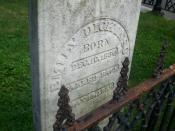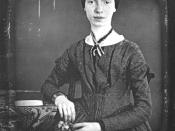Emily Dickinson is the best-known female poet of the English language, and also one of the foremost authors in American literature. She was born in 1830 in Amherst Massachusetts where she lived a very peculiar life. She hardly ever left her house and she confined herself to her room to live in privacy. While in her room, Dickinson created over seventeen hundred pieces of poetry. Of these, only ten were published during her lifetime. The rest weren't released until they were found after her death in 1886. Her poems are a passionate representation of how she felt and what her life was like. She put all of her heart and soul into her poetry. Her poetry reflects her loneliness and the speakers of her poems generally live in a state of want. Dickinson's intellectual writings take as their subject issues vital to humanity. There is always one of four central themes in any of her works.
Her poems contain the concept of joy, love, death, or immortality. The most predominant theme out of all of Dickinson's poetry is the subject of death. She never titled any of her poems therefore when they were published they were each given a number. Poems numbered 712, 280, and 465 all portray Emily Dickinson's main focus of death.
Emily Dickinson's poem with the opening line "Because I could not stop for death", numbered 712, speaks entirely about the concept of death and dying. In this poem death is personified. He is the driver of a carriage that has picked up the speaker. He has stopped his wagon and out of this gesture he has "kindness" and "civility". His driving slowly is an expression of his thought and consideration for her. This carriage could also be viewed as a hearse. The drive symbolizes...


